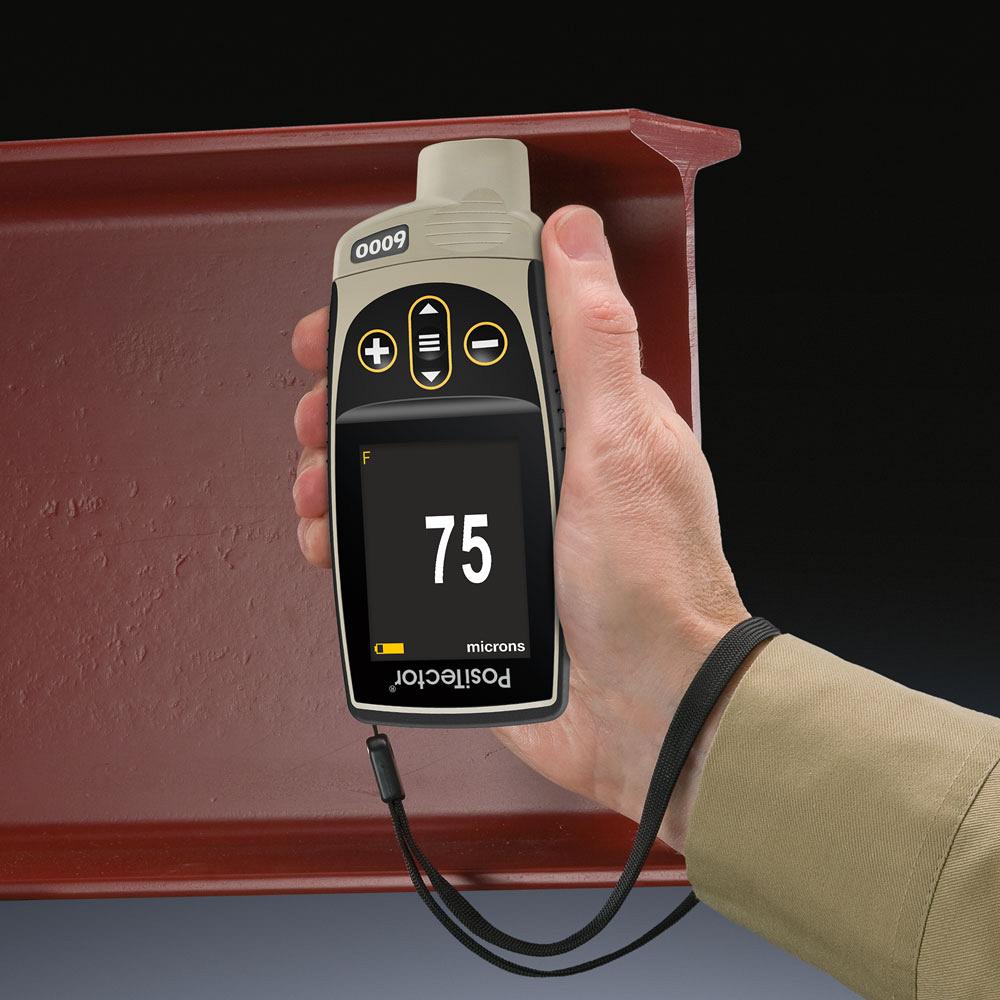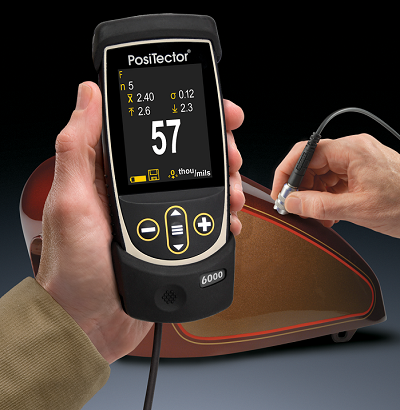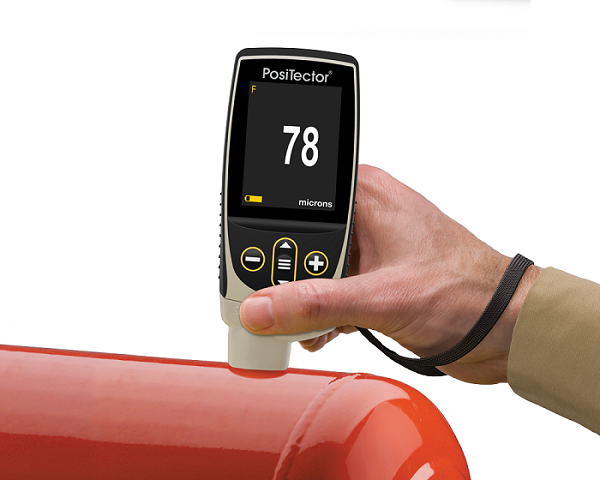- FMA
- The Fabricator
- FABTECH
- Canadian Metalworking
How to measure coating thickness on stainless steel
Measuring paint thickness helps ensure the longevity of the coating system
- January 17, 2022
- Article
- Measurement

A reliable coating thickness gauge is one of the most important instruments in an inspector’s tool kit. It helps control material costs, manage application efficiency, maintain finish quality, and ensure compliance with contract specifications.
Non-destructive testing devices are used to measure paint and coating thickness to meet project requirements. The varying magnetic properties of stainless steel make measuring paint thickness particularly challenging, so using the right equipment with the correct settings is critical. Michael Beamish, vice-president, DeFelsko Corp., Ogdensburg, N.Y., discusses how best to measure coating thickness on stainless steel.
Canadian Fabricating & Welding: What is the benefit of painting or coating stainless steel, and why is it important to measure coating thickness?
Michael Beamish: Stainless steel is commonly used for its resistance to corrosion, making it a long-lasting and cost-effective option. The chromium present in stainless steel reacts with oxygen to form a thin, inert oxide layer over the entire surface that provides corrosion resistance and regenerates itself when damaged. In addition to its inherent corrosion protection, stainless steel often is coated to provide additional corrosion resistance or for decorative and aesthetic purposes. Coating stainless steel helps to protect against wear and tear caused by weather and other factors.
Measuring coating thickness is a vital step in ensuring the longevity of the coating system. Thickness is arguably the single most important measurement made during application and inspection of coatings. A coating that is too thin may fail prematurely, may show bare substrate through the coating, or may not have the performance properties required of the finished film. A coating that is too thick can crack, may not have correct colour or gloss, or may just be a waste of paint.
A reliable coating thickness gauge is therefore one of the most important instruments in an inspector’s tool kit. It helps control material costs, manage application efficiency, maintain finish quality, and ensure compliance with contract specifications. Paint manufacturers recommend target ranges to achieve optimum performance characteristics, and clients expect these parameters to be met.
CFW: What are some of the challenges with measuring coating thickness on stainless?
Beamish: Measuring the thickness of coatings applied to stainless steel substrates can be difficult for conventional hand-held inspection instruments because of the varying magnetic properties of the different grades of stainless steel.
Stainless steel can be magnetic, non-magnetic, or partially magnetic. These properties must be considered when selecting a suitable coating thickness gauge.
Ferritic stainless steels are magnetic and include the 400-series grades, which offer excellent corrosion resistance and ductility.
Martensitic stainless steels contain both 400- and 600-series grades and are also magnetic, with less corrosion resistance compared to other families.
Austenitic stainless steel is most commonly used and has the highest number of grades, specifically the 200, 300, and 900 series. This family of steels is generally non-magnetic. However, austenitic stainless steels can become partially magnetic when cold-worked. The specific material composition also can affect the degree of magnetism, as can the addition of nickel.
Duplex stainless steels contain a mixture of both austenitic and ferritic stainless steels, which provide a higher level of corrosion resistance and strength than the 300-series grades. This family is typically magnetic, but because duplex stainless steels contain a higher content of austenitic than ferritic steels, they may be less magnetic.

Stainless steel can be magnetic, non-magnetic, or partially magnetic, so these properties must be considered when selecting a suitable coating thickness gauge.
Taking accurate coating thickness measurements and getting a repeatable zero may be difficult on stainless steels that are partially magnetic or that have inconsistent levels of magnetism due to varying degrees of cold working. Many conventional coating thickness gauges will rarely measure accurately because of the weak and inconsistent magnetic field.
CFW: What devices or test methods work best for the various types of stainless steel?
Beamish: Measuring non-magnetic coatings applied to magnetic stainless steel substrates is straightforward using magnetic principle gauges.
Eddy-current gauges are ideal for measuring non-conductive coatings applied to non-magnetic stainless steel substrates.
Stainless steel can be magnetic, non-magnetic, or partially magnetic, so these properties must be considered when selecting a suitable coating thickness gauge.
Combination gauges, which combine magnetic and eddy-current technologies, provide accurate coating thickness measurements on nearly all families and grades of stainless steel, including magnetic, nonmagnetic, and partially magnetic stainless steels. They first detect whether there is any magnetism present in the substrate. If so, measuring is done using the magnetic method; if not, then the eddy-current method is used.
As with the other gauges, it is recommended to check for a repeatable zero on the uncoated part and perform an adjustment if needed. These gauges are uniquely capable of overcoming the measurement challenge presented by partially magnetic stainless steels, provided that the applied coating is non-conductive. For example, the PosiTector 6000 FN instrument features N-Lock (non-ferrous lock) mode, which causes the gauge to exclusively use eddy-current measurement. The rare-earth magnet housed within the probe saturates the weak magnetic field that would otherwise interfere with the eddy-current measurement, effectively turning a partially magnetic substrate into a temporarily non-magnetic substrate. The gauge will then be capable of obtaining accurate and repeatable coating thickness readings over stainless steel, regardless of inconsistent or partial magnetism.
CFW: What devices or methods are not recommended and why?
Beamish: Generally, one of the biggest mistakes users make when trying to measure coating thickness with an electronic gauge is to try and “calibrate” the gauge or change the settings.
For highest confidence and best measurement accuracy, simply observe the golden rule—check zero (or the known thickness of a shim) on the uncoated part, adjust if necessary, and then measure the coated part.
This ensures that the probe is properly adjusted for substrate characteristics including mass, metallurgy, curvature, temperature, and roughness.
CFW: What are some common misconceptions with paint and coating thickness gauges?
Beamish: A common misconception with coating thickness gauges is that they are difficult to use and require complicated setup. However, modern coating thickness measurement gauges are simple and non-destructive.

DeFelsko’s PosiTector 6000 FN is used to measure paint thickness on a steel tank. This gauge combines both magnetic and eddy-current technologies to measure on magnetic and non-magnetic substrates.
The old concept that a single gauge could only be used for a single application is no longer true, either.
Modern gauges feature probe interchangeability that is backwards-compatible with previous models. For example, the PosiTector gauge body easily converts from a coating thickness gauge to a surface profile gauge, dew point meter, soluble salt tester, hardness gauge, and ultrasonic thickness gauge.
CFW: What best practices or tech tips would you suggest for effective measurement?
Beamish: When measuring, the probe face should be placed flush with the coating surface and should be lifted completely from the surface between readings.
It is important to identify the specific grade of stainless steel being used and the magnetic properties of both the grade and coating. These specifications are needed to select the correct dry film coating thickness instrument. To measure coatings over ferrous substrates, the coating must be non-magnetic. Over non-ferrous and partially magnetic grades, the coating must be non-conductive.
DeFelsko, www.defelsko.com
subscribe now


Keep up to date with the latest news, events, and technology for all things metal from our pair of monthly magazines written specifically for Canadian manufacturers!
Start Your Free Subscription- Industry Events
Automate 2024
- May 6 - 9, 2024
- Chicago, IL
ANCA Open House
- May 7 - 8, 2024
- Wixom, MI
17th annual Joint Open House
- May 8 - 9, 2024
- Oakville and Mississauga, ON Canada
MME Saskatoon
- May 28, 2024
- Saskatoon, SK Canada
CME's Health & Safety Symposium for Manufacturers
- May 29, 2024
- Mississauga, ON Canada




















